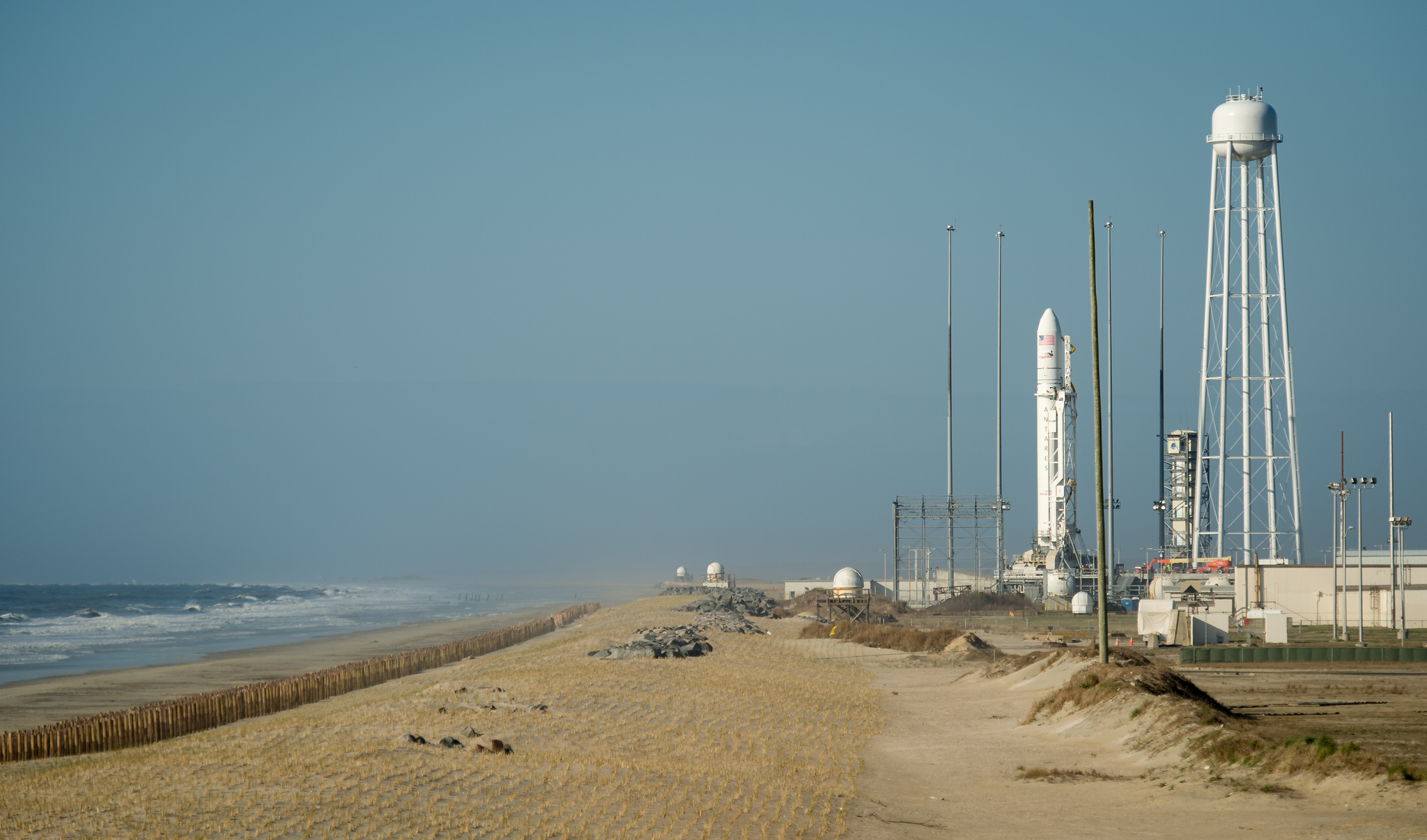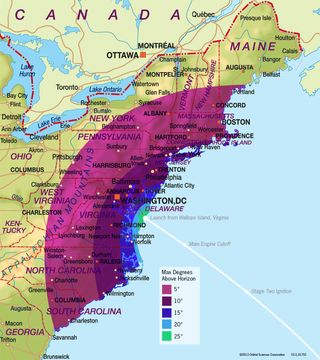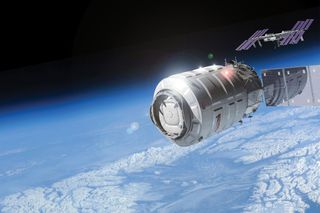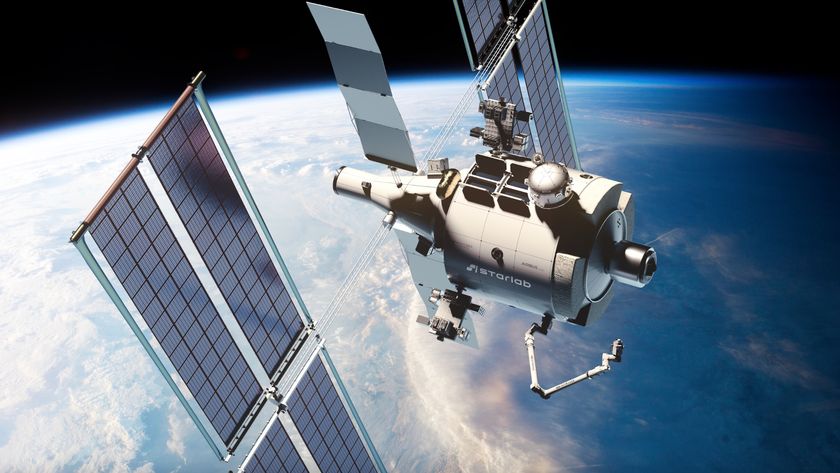New Private Rocket Launching on 1st Flight Today: Watch It Live

A new American rocket designed to fly cargo missions to the International Space Station for NASA is poised to make its launch debut from the U.S. East Coast today (April 20) after a three-day delay.
The private Antares rocket, built by the commercial spaceflight company Orbital Sciences Corp., is set to launch from a new seaside pad at NASA's Wallops Flight Facility on Wallops Island, Va.. The critical test flight has been delayed since Wednesday (April 17). Liftoff is now set for 6:10 p.m. EDT (2210 GMT; concerns about high-level winds pushed back the original target of 5:00 p.m. EDT).
You can watch the Antares rocket launch live on SPACE.com beginning 5:30 p.m. EDT (2130 GMT), courtesy of a NASA TV webcast. Weather permitting, the rocket's ascent toward space may even be visible from a wide swath of the U.S. East Coast from Portland, Maine, to Charleston, S.C., according to an Orbital visibility map. [What the Antares Rocket Launch May Look Like (Photos)]

The Antares rocket is designed to launch Orbital's new unmanned Cygnus spacecraft on cargo missions to the International Space Station under a $1.9 billion contract with NASA. Under the deal, the Dulles, Va.-based Orbital has pledge to launch at least eight Cygnus flights using Antares to deliver a total of 20 tons of cargo to the station through 2016.
But first, Orbital officials want to be sure the two-stage rocket can perform as expected. That's where today's test launch, called the Antares A-ONE mission, comes in.
Orbital is launching a full Antares rocket topped with a cylindrical dummy payload that mimics the shape and weight of the Cygnus spacecraft. If all goes well, the rocket will blast off at 6:10 p.m. EDT and reach orbit about 10 minutes later to place the Cygnus mass simulator in orbit.
Orbital initially tried to launch the Antares rocket on Wednesday (April 17), but a data cable separated from the booster earlier than expected minutes before liftoff. The cable relays vital commands from Orbital's launch control center to the Antares rocket's computer brain, so engineers wanted to be sure the rocket was in pristine shape to fly. A simple fix — adding some extra slack in the cable — was made to clear the way for today's launch attempt.
Get the Space.com Newsletter
Breaking space news, the latest updates on rocket launches, skywatching events and more!
Orbital officials also opted to skip a Friday launch attempt because of dismal weather forecasts, but conditions at launch time today on Wallops Island are expected to be favorable.
The 13-story Antares rocket is the largest booster ever to launch from NASA's Wallops Flight Facility, which has long been the home of NASA's small sounding rocket launches and balloon science program. The rocket will lift off from Pad 0A, a new launch pad operated by the Mid-Atlantic Regional Spaceport and overseen by the Virginia Commercial Spaceflight Authority.
Orbital Sciences is one of two U.S. companies that have contracts with NASA to provide commercial cargo deliveries to the International Space Station using robotic spacecraft. The other firm is Space Exploration Technologies (SpaceX) of Hawthorne, Calif.
SpaceX has a $1.6 billion contract to fly at least 12 cargo delivery missions to the space station using its Falcon 9 rockets and robotic Dragon space capsules. The company launched its first test flight to the station in May 2012 and has flown two official cargo deliveries since then.

With the retirement of the U.S. space shuttle fleet in 2011, NASA is relying on private spacecraft like those built by Orbital and SpaceX not only to keep the space station stocked with supplies, but eventually to ferry American astronauts to and from the orbiting lab.
If you live near the Wallops Island area in Virginia and want to watch today's launch attempt, NASA's Wallops Flight Facility Visitors Center is open to the public. The launch can also be viewed from the nearby Assateague National Seashore.
Editor's note: If you snap a great photo of Orbital's Antares rocket launch that you'd like to share for a possible story or image gallery, send photos, comments and your name and location to managing editor Tariq Malik at spacephotos@space.com.
Email Tariq Malik at tmalik@space.com or follow him @tariqjmalik and Google+. Follow us @Spacedotcom, Facebook and Google+. Original article on SPACE.com.
Join our Space Forums to keep talking space on the latest missions, night sky and more! And if you have a news tip, correction or comment, let us know at: community@space.com.

Tariq is the Editor-in-Chief of Space.com and joined the team in 2001, first as an intern and staff writer, and later as an editor. He covers human spaceflight, exploration and space science, as well as skywatching and entertainment. He became Space.com's Managing Editor in 2009 and Editor-in-Chief in 2019. Before joining Space.com, Tariq was a staff reporter for The Los Angeles Times covering education and city beats in La Habra, Fullerton and Huntington Beach. In October 2022, Tariq received the Harry Kolcum Award for excellence in space reporting from the National Space Club Florida Committee. He is also an Eagle Scout (yes, he has the Space Exploration merit badge) and went to Space Camp four times as a kid and a fifth time as an adult. He has journalism degrees from the University of Southern California and New York University. You can find Tariq at Space.com and as the co-host to the This Week In Space podcast with space historian Rod Pyle on the TWiT network. To see his latest project, you can follow Tariq on Twitter @tariqjmalik.











